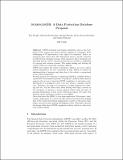| dc.contributor.author | Kraska, Tim | |
| dc.contributor.author | Stonebraker, Michael | |
| dc.contributor.author | Brodie, Michael | |
| dc.contributor.author | Servan-Schreiber, Sacha | |
| dc.contributor.author | Weitzner, Daniel J | |
| dc.date.accessioned | 2022-07-22T16:41:02Z | |
| dc.date.available | 2021-09-20T18:21:38Z | |
| dc.date.available | 2022-07-22T16:41:02Z | |
| dc.date.issued | 2019 | |
| dc.identifier.uri | https://hdl.handle.net/1721.1/132280.2 | |
| dc.description.abstract | © 2019, Springer Nature Switzerland AG. GDPR in Europe and similar regulations, such as the California CCPA, require new levels of privacy support for consumers. Most challenging to IT departments is the “right to be forgotten”. Hence, an enterprise must ensure that ALL information about a specific consumer be deleted from enterprise storage, when requested. Since enterprises are internally heavily “siloed”, sharing of information is usually accomplished by copying data between systems. This makes finding and deleting all copies of data on a particular consumer difficult. GDPR also requires the notion of purposes, which is an access control model orthogonal to the one customarily in SQL. Herein, we sketch an implementation of purposes and show how it fits within a conventional access control framework. We then propose two solutions to supporting GDPR in a DBMS. When a “green field” environment is present, we propose a solution which directly supports the process of ensuring GDPR compliance at enterprise-scale. Specifically, it is designed to store every fact about a consumer exactly once. Therefore, the right to be forgotten is readily supported by deleting that fact. On the other hand, when dealing with legacy systems in the enterprise, we propose a second solution which tracks all copies of personal information, so they can be deleted on request. Of course, this solution entails additional overhead in the DBMS. Once data leaves the DBMS, it is in some application. We propose “sandboxing” applications in a novel way that will prevent them from leaking data to the outside world when inappropriate. Lastly, we discuss the challenges associated with auditing and logging of data. This paper sketches the design of the above GDPR compliant facilities, which we collectively term SchengenDB. | en_US |
| dc.language.iso | en | |
| dc.publisher | Springer International Publishing | en_US |
| dc.relation.isversionof | 10.1007/978-3-030-33752-0_2 | en_US |
| dc.rights | Creative Commons Attribution-Noncommercial-Share Alike | en_US |
| dc.rights.uri | http://creativecommons.org/licenses/by-nc-sa/4.0/ | en_US |
| dc.source | Other repository | en_US |
| dc.title | SchengenDB: A Data Protection Database Proposal | en_US |
| dc.type | Article | en_US |
| dc.contributor.department | Massachusetts Institute of Technology. Computer Science and Artificial Intelligence Laboratory | en_US |
| dc.contributor.department | Massachusetts Institute of Technology. Department of Electrical Engineering and Computer Science | en_US |
| dc.relation.journal | Lecture Notes in Computer Science (including subseries Lecture Notes in Artificial Intelligence and Lecture Notes in Bioinformatics) | en_US |
| dc.eprint.version | Author's final manuscript | en_US |
| dc.type.uri | http://purl.org/eprint/type/ConferencePaper | en_US |
| eprint.status | http://purl.org/eprint/status/NonPeerReviewed | en_US |
| dc.date.updated | 2021-01-11T16:38:23Z | |
| dspace.orderedauthors | Kraska, T; Stonebraker, M; Brodie, M; Servan-Schreiber, S; Weitzner, D | en_US |
| dspace.date.submission | 2021-01-11T16:38:26Z | |
| mit.journal.volume | 11721 | en_US |
| mit.license | OPEN_ACCESS_POLICY | |
| mit.metadata.status | Publication Information Needed | en_US |
